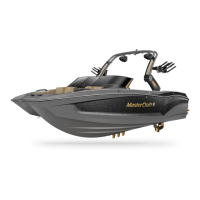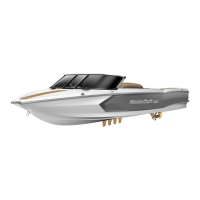in illustration above) will bring the system back to neutral and reduce
the engine RPMs to pre-set levels.
This function should be done sparingly. Over-revving the engine for
any extended period can cause undue wear and tear on the engine. Avoid
advancing to wide-open-throttle and holding the RPMs at that level.
In the MariStar 280 and X-80 the boat is equipped with a four-le-
ver control. The port side lever closest to the driver is the port engine
shifter, which allows the boat to move forward when shifted forward,
and backward when shifted aft. The next lever is the starboard engine
shifter and performs the same function. If both engines are running
and the boat is moving, the shifters should be shifted together and in
the same direction. Doing otherwise can damage the system.
The next middle lever is the port engine throttle, which allows the
boat to feed fuel into the engine and operate in motion. Pushing forward
on it will signal the system that fuel should be sent to the port engine. The
engines can be run at different levels of throttle.
The CSX 265 has a two-lever control. On the port side is the port
engine shifter/throttle control, and pushing forward will move the boat
forward. The starboard side lever is the starboard engine shifter/throttle
control. The engines can be run at different levels of throttle.
This system allows greater maneuverability in docking, as well as
when the boat is in operation. However, it requires more practice
and skill in order to avoid potential damage to the boat. See
Engine Synchronizing Switch in this section of the Owner’s
Manual for more details.
During regular warm-up of the engine, it is possible to temporarily
increase the engine RPMs without moving the boat. To accomplish this,
pull outward (lateral to the unit) on the engine shift/throttle control.
The engine will run with increased RPMs and can be increased or
decreased by moving the lever. Returning the handle to the neutral
position (as shown in illustration above) will bring the system back to
neutral and reduce the engine RPMs to pre-set levels.
This function should be done sparingly. Over-revving the engine for
any extended period can cause undue wear and tear on the engine. Avoid
advancing to wide-open-throttle and holding the RPMs at that level.
Underway
If the oil pressure gauge indicates low or no oil pressure, imme-
diately stop the boat as outlined below and check the oil level. If the
temperature gauge indicates overheating, immediately stop the boat
as outlined below and check the raw water impeller for blockage. DO
NOT operate the boat until the cause for the warning has been found
and corrected.
Continued operation after the warning light has il-
luminated may cause severe engine damage. This will
void your warranty.
Stopping
Step 1: Slowly bring the control lever to the neutral position. If the
boat has been driven for a long period of time or at high
speed, allow the engine a 2-3 minute cool-down period at
low idle (600-800 RPM).
Step 2: Turn the ignition key to the OFF position to stop the en-
gine.
Step 3: If any problems were encountered during operation, have
the boat inspected by an authorized MasterCraft dealer. Re-
quest any necessary repairs before resuming operation of
the boat.
mastercraft 2010 ow n e r ’s m anual • page 10 -2
Port engine shifter
Port engine throttle
Starboard engine throttle
Starboard engine shifter
MariStar 280, X-80
Port engine
combined
shifter/
throttle
Starboard
engine
combined
shifter/
throttle
CSX 265

